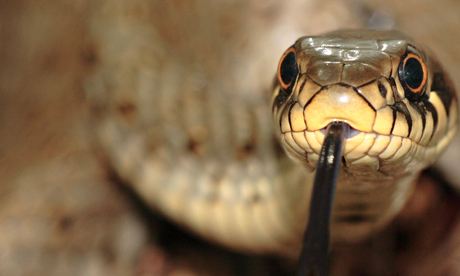
I wrote to Gerald Durrell when I was seven, asking how best I could become him. He – marvellously – replied, saying: feed the birds in your garden, watch out for dropped feathers and old nests, look down for beetles and up for butterflies, take a net to your local pond and dip it, get glass jars ("ask your mother…") and keep what you can catch. These were thrilling instructions for a suburban child, and they answered something deep in me, a desire for some contact with nature I was barely aware I needed.
I followed the advice to the letter. But by the mid-70s, any such junior harvesting of wildlife was regarded increasingly as illegitimate. Nature tables in schools became vexed places and soon disappeared. Everyone had been taught to be its friend, but from then on, only designated experts were to be allowed to grab hold of nature.
Richard Kerridge's Cold Blood is made out of this same time, and from similar childhood obsessions and experiences. The title is a nod to 17 species of British reptiles and amphibians. Where I went for feathers, Kerridge stuck with jam jars, a net made from an old pair of underpants, and a friend (there was always someone even more keen and nerdy) called Microscope. At one time, Kerridge had several snakes and lizards secreted in an old bath in his garden and spent hours collecting grasshoppers to feed to his reptile zoo. Who needs the Serengeti or the Amazon when you've got the ditches of Camber and the heath at Studland?
Most of his captives died or escaped, only a few endured, but there were always more to be stalked in the "folds" of the earth. More, that is, then. The young Kerridge snatches up an adder by its tail in front of his friends, and minutes later one of them does the same with another snake; the older Kerridge stops his car and kneels alone to the tarmac to assist some toads in their nocturnal migrations, and finds himself talking half to them and half to a bewildered passerby about the imperilled creatures. His lovely book swings between these and parallel encounters: the death, of sorts, of a young naturalist and his accumulation of wisdom through the trials of life.
But Cold Blood is more than a memoir of childhood passion morphing into adult thoughtfulness and concern. It begins with a primal encounter and ends with a list of helpful websites, but it arrives in the thick of a publishing movement that is hoovering up British animals (me and hawks, me and otters, me and butterflies) and British landscapes (me and moors, me and paths, me and meadows), and it captures the prevailing mood. Nature in these books is not primarily there for itself, but rather is being used – harvested in another way – to write about all the old truths of human nature, about love, life, childhood, death.
Cold Blood has a father who says "No!" to almost everything; it has a pervert in a park and pre-teen confusion about pubic hair; it has gaucheries with girls, and encounters with death (a palmate newt's). Our early years toss this cold-blooded slaughter of innocence and enthusiasm before all of us. The difference here is that the cold-blooded crew help their keeper cool his ardour even as they stir it. Reptiles and amphibians afforded the young Kerridge a "refuge" from the world at large. And his adult nature writing becomes, as in several other comparable books of the moment, a kind of therapeutic life-writing. What once would have been derided as eccentric and singular (Richard and his blessed newts!) is written up now as the early manifestation of an authentic personality, and might function as a gloss for a whole life (You may see me for what I was and what I am through my love, yes, for frogs!).
Cold Blood casts an unexpected but beautiful love-light across ordinary England, and its uncaring reptiles and amphibians. Snakes are usually thought scary and frogs funny. Half the animals in the book have a cultural presence somewhere between Kermit and "Krak! Krek! Krik!" (Samuel Beckett's transcription of a frog chorus in Watt), but Kerridge brilliantly allows them an emotional power far beyond this, born out of his intimate knowledge and his honesty about his own need for them. He accompanies this with several searching pages on anthropomorphism ("we need it and we need to overcome it"), and a sharp-minded investigation into the difficulties of thinking, as the philosopher Thomas Nagel put it of another class of animals, what is it like to be a bat?
Much emerges from this blurry territory that is interesting, that is both wildly remote from us and yet, as told, seems tender and intimate. Kerridge is able to write his creatures so they come "close to [his] face". He is great, above all, at cold-blooded sex. Froggy went a-courting but no amphibian has a penis. When she is ready, a female common toad permits the male clinging to her back to rest his feet in the cloaca that opens between her legs. His feet there prompt strings of her eggs to appear and he ejaculates his sperm from his own cloaca onto them, coming to his climax as the eggs touch his toes and his soles: it's a two-step to toad heaven.
Tim Dee is the author of The Running Sky and of Four Fields

